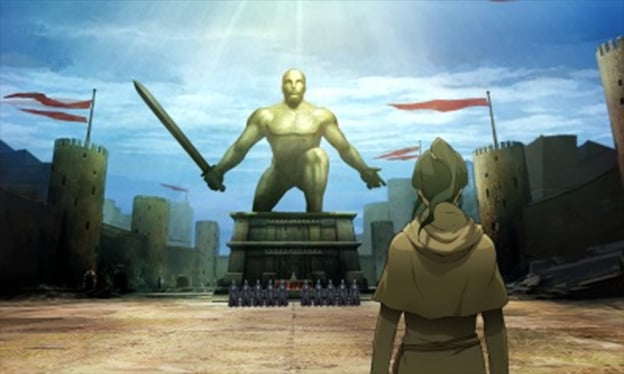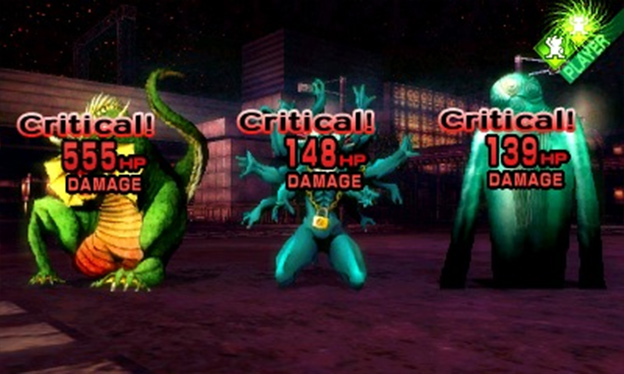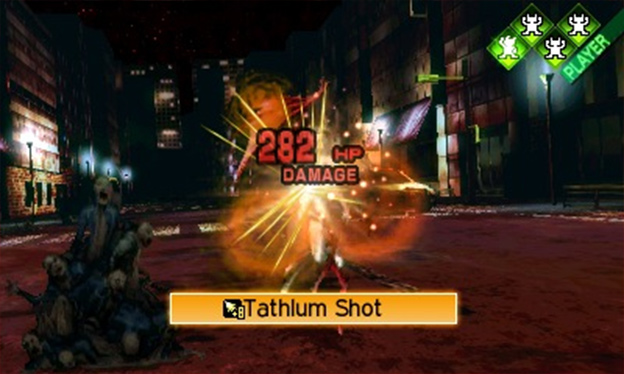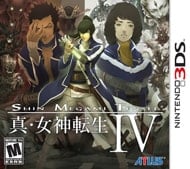Flirting with Demons Is Flirting with Disaster
If you’re like me and discovered the Shin Megami Tensei ( SMT ) series through its Persona spinoffs and their addictive mix of RPG battles and social simulation, you’ve probably been curious about the main series. Classic SMT games are known as turn-based dungeon crawlers featuring a punishing difficulty level and some seriously twisted storylines. Yes, even more twisted than having school kids point Evoker guns at their heads to summon the avatars of their inner selves for combat purposes.
Enter Shin Megami Tensei IV , the first main SMT game to come out since 2004. It breaks tradition with earlier titles by starting players off in a positively medieval setting, the Eastern Kingdom of Mikado. Does this change in setting mean that the series has also changed its trademark difficulty level or mix of wacked-out philosophy and horror? Not from what I was able to tell from my experience with SMT IV .
Stepping into the shoes of a samurai, a young demon-hunter in Mikado, certainly isn’t easy. The demons are restless, and there’s tension on your squad between the upper-caste Luxurors and those who come from the working Casualry caste. It’s not long before these simple caste distinctions fade into the background, replaced by an urgent mission with world-shattering implications. The pastoral world into which your character was born is far more than it seems, with catastrophe (and a bizarre twist) literally lurking just below the surface.
Surviving samurai missions involves not only fighting hordes of demons, but also recruiting some of them to fight by your side. Successfully negotiating with demons involves a mixture of flattery, bravado, bribery, dishonesty, and just plain luck. It’s one of the most interesting parts of the game, especially the first time a demon takes the piles of money and valuable items you’ve just given it and absconds with a giggle. That’s when you learn that it’s a game of giving the demon as little as possible while convincing it that you’re actually giving it a lot.
With a variety of colorful personalities, your demon teammates often seem more three-dimensional than your human companions, who are too obviously designed to represent specific philosophical viewpoints. You’ll be choosing between taking the path of Order and Chaos during the game, and your friends Jonathan and Walter spend most of the time trying to pull you towards the side they each represent. You don’t get too many chances to relate to your fellow samurai on a human level, especially since your character is silent and only speaks in order to make important storyline choices.

That storyline, at least, is fairly interesting, with plenty of twists and a setting that’s fascinating to learn about. There seems to be a purposeful emotional distance between the player and the story, which may be for the best, since a lot of grotesque and awful things happen during the adventure. It’s more a story for the intellectually curious, especially for those who are drawn to the uniquely Japanese take on religion found in this series.
Before experiencing the story, though, you’ll have to survive samurai “training,” which basically involves throwing apprentices head-first into a pit full of demons and seeing who comes out alive. Unlike many RPGs, this premise isn’t simply a ruse to make players feel good about themselves. The beginning of SMT IV is the most difficult part of an already-difficult game. Save early and save often, because you will die.

You will die because you didn’t press X quickly enough to get a preliminary hit on enemy demons and they wiped out your entire party before you could even take a turn. You will die because you failed to recruit a demon and it turned around and kicked your rear. You will die because you jumped off a ledge into a group of demons and didn’t have time to get in that vital preliminary hit. You will die because you wandered into a surprise boss fight for which you were unprepared. You will die because you underestimated the importance of fusing two weaker demons together in order to make more powerful demons, and your team wasn’t powerful enough to take on a new challenge.
Once your party is set up with a full team of fused demons, the going gets easier, but it’s never a cakewalk. There’s little in the way of defense to be had, and you’ll always be vulnerable to some element or another, so enemy moves remain quite dangerous throughout the game. Winning battles means taking advantage of the Press Turn battle system, which works for the player’s party and enemies alike. “Press Turn” means that scoring a critical hit or exposing an enemy’s weakness grants extra attacks, while missing or using the wrong element against the enemy reduces a party’s actions. Use it well and your party of four will get six or seven attacks before the enemy can take a turn. Of course, the enemy can do the same thing.
While this adds an interesting layer of strategy, it unintentionally removes some of the complexity that has traditionally been found in SMT’s battle system. Risky instant-kill attacks like Hama and Mudo, as well as debuffing moves that do things like poison or put enemies to sleep, are rarely worth the risk in this game. If they miss, they not only fail to damage the enemy but cause the player to lose valuable combat turns. Since enemy moves are so lethal, it’s generally best to spam physical or elemental attacks that guarantee damage and keep the party’s turns going rather than those that have a higher chance of missing the enemy. The designers probably should have changed the way that low-hit attacks (particularly Hama and Mudo, which represent entire elements in themselves) work in order to better integrate them into the Press Turn system.
The lethal nature of battles keeps them fairly short, but the high risk of disaster and frequent encounter rate means that only players with a high level of patience and an established love of turn-based combat will have the energy to get very far in Shin Megami Tensei IV . There’s absolutely nothing wrong with this, because the game does what it does very well. We’ll call it Dark Souls for the turn-based crowd. If you’re up for a game that, like its demonic inhabitants, doesn’t care if you live or die, this one is more than happy to welcome you into its thorny embrace.
There’s been some debate over the aesthetics of the game, although the SMT series has never been known to be graphically on the cutting edge. Outside of dungeons, many activities take place against still backgrounds that resemble nineteenth-century paintings in their general style and color palette. Dungeons and other dangerous areas feature 3D graphics, though battles switch back to 2D sprites. Although somewhat dreary and lacking a unified style between the 3D and 2D segments, I found the graphics to be properly evocative of the game’s themes, and the 2D sprites (especially the demons) to be as excellently designed as always.

In fact, if you’ve never experienced the crazy menagerie that is SMT’s demonic compendium, this game might be worth it simply to do so. Inspired by folklore and religions from all corners of the Earth, the demon designs range from adorable to genuinely creepy to delightfully bizarre. Everybody loves the cuddly Jack Frost, but the Dybbuk possessor demon is designed to make you shiver, and the ambulatory penis-demon Mara just dares you not to crack a smile. Even more than the Persona games, SMT IV demonstrates why this series is sometimes referred to as Pokemon for grown-ups.
The game’s soundtrack is highly atmospheric, lacking in the cool hip-hop tracks that pervade the Persona games. Instead, it ranges from grinding electronica to traditional organ music, depending on the situation. It’s just about exactly the kind of music one might expect from the kind of game it is, and it tends to set the mood quite effectively, even if none of it will ever get stuck in your head. The voice acting is completely unexceptional; it’s not awful, but there’s not a lot of emotion put into it, either. In general, the look and sound of the game contribute to its atmosphere, but they aren’t particularly exceptional examples of video game art.
Shin Megami Tensei IV is the kind of game that has some people doing their happy dance and others running for the hills. If you’re looking for hard-won victories, an impressive collection of demons, and some genuine Crazy Japanese Stuff (I say that with all affection) to be had from the story, then congratulations. This game is for you, and like me, you’ll get a kick out of it. If you’re more interested in heartwarming stories, relatable characters, or relaxation from your RPGs, I recommend checking out the Persona 3 and 4 instead.
RATING OUT OF 5 RATING DESCRIPTION 3.5 Graphics
The demons are great; the rest is competent but not exceptional. 3.5 Control
Initiating battle can be awkward sometimes, but otherwise, it’s all menus. 3.7 Music / Sound FX / Voice Acting
The music rarely asks for attention, but supports the game’s atmosphere well. 4.0 Play Value
For its audience, SMT IV offers a palpable challenge and many hours of demon-collecting fun. 3.8 Overall Rating – Good
Not an average. See Rating legend below for a final score breakdown.
| Review Rating Legend | |||
|---|---|---|---|
| 0.1 – 1.9 = Avoid | 2.5 – 2.9 = Average | 3.5 – 3.9 = Good | 4.5 – 4.9 = Must Buy |
| 2.0 – 2.4 = Poor | 3.0 – 3.4 = Fair | 4.0 – 4.4 = Great | 5.0 = The Best |
Game Features:
